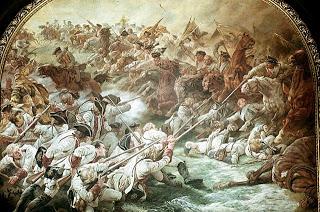 One of history's most unbelievable anecdotes involves the "Battle of Karansebes." It's a staggering, unbelievable tale cited as the epitome of military incompetence, with an Austrian army massacring itself through panic and drunken misunderstanding. Unfortunately, there's no evidence that this catastrophe actually occurred - at least in the form we know it.
One of history's most unbelievable anecdotes involves the "Battle of Karansebes." It's a staggering, unbelievable tale cited as the epitome of military incompetence, with an Austrian army massacring itself through panic and drunken misunderstanding. Unfortunately, there's no evidence that this catastrophe actually occurred - at least in the form we know it.In 1787, Russia and the Ottoman Empire went to war in a dispute over territory along the Danube River. Austria's Emperor Joseph II, seeking to strengthen ties with Russia, entered the war a year later. Some records indicate that he dreamed of a Christian alliance to drive the hated Turks from Europe: "The Russians would cross the Danube at Galati and together we could travel downriver and enter the Black Sea. From there, we could storm Constantinople and finish the job."
But Joseph was motivated as much by realpolitik as imperial fantasies. His efforts at political reforms (along with patronage of artists like Wolfgang Amadeus Mozart) triggered a backlash from Austria's conservative nobility, threatening his authority. Then there was simple pragmatism: he had formed an alliance with Russia's Catherine the Great for mutual defense against Prussia, still the bugbear of Central Europe a year after Frederick the Great's passing. Domestic and external motivation thus compelled Joseph to undertake an ill-conceived campaign.
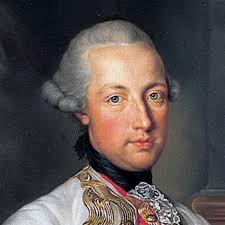
Joseph II
After a failed attack on Belgrade in January 1788, Austria formally declared war in February. Joseph and his chief-of-staff, Field Marshall Lacey, organized an impressive army of nearly 300,000 men and 1,100 guns ("one of the largest artillery parks in Europe," according to an historian). Early fighting proved indecisive; Austrian troops reduced the Turkish fortress at Klanack, just north of Belgrade, in late March but failed to follow up with an assault on that city. The cautious Lacy convinced Joseph to maintain a defensive posture, ceding initiative to the Turks who launched counterattacks into Croatia and other extremities of the Austrian Empire.With the Turks shifting their forces towards Russia, Joseph dithered. Several of his advisers urged him to withdraw from the conflict, but the Emperor refused. After Austria's defeats in the spring, "it will not be possible to force the Turks into accepting a fair and honorable peace." The war dragged on through the summer, with skirmishing in Transylvania and Croatia but no major actions between Austria and Turkey. Outbreaks of malaria and other diseases further sapped Austria's will for offensive action.
Joseph's indecision allowed the Turks to take the offensive, moving into the Banat (in western Romania) in August. Initially, Joseph ignored the attacks, still plotting his own descent on Belgrade; but a disastrous defeat at Szupany, on the north bank of the Danube, on August 4th convinced the Emperor to join his command. Further defeats awaited Austrian forces at Mehadia, leading Joseph to admit that events "leave me in a state of confusion and ignorance." In September he concentrated 100,000 men near Caransebeș, a small village in modern-day Romania, in preparation for a counterattack.
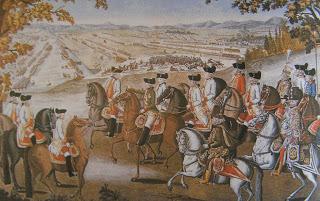 What follows next skirts the line between myth and history. According to the popular account, on the evening of September 21st an advance guard of Austrian hussars purchased schnapps from a group of Gypsies. A detachment of infantry soon followed and there was an angry row over the alcohol. At some point a hussar fired a shot at the infantry, leading to a violent confrontation between the two groups. Someone shouted that the Turks were coming, leading the hussars to stampede into the main Austrian camp nearby.
What follows next skirts the line between myth and history. According to the popular account, on the evening of September 21st an advance guard of Austrian hussars purchased schnapps from a group of Gypsies. A detachment of infantry soon followed and there was an angry row over the alcohol. At some point a hussar fired a shot at the infantry, leading to a violent confrontation between the two groups. Someone shouted that the Turks were coming, leading the hussars to stampede into the main Austrian camp nearby.Pandemonium reigned. Officers tried to restrain the panicked cavalrymen by shouting "Halt!"; Slavic infantrymen with little understanding of German misheard it as "Allah," assuming the Turks were upon them and opened fire. Wallachian infantrymen inexplicably put a nearby village to the torch, adding civilians to the death toll. The situation escalated further when an Austrian general ordered his artillery to fire into the camp, raining death on his own men. Joseph II tried to clear up the mess, but a shell knocked him from his horse and into a lake. He could only watch as his army destroyed itself.
By the time the smoke cleared, the Austrians had lost nearly 10,000 men, roughly a tenth of Joseph's force. The Turkish Army was baffled, but happy to score an easy, bloodless victory without lifting a finger; they occupied Karansebes and forced Joseph's scattered forces to withdraw. Or so goes the story.
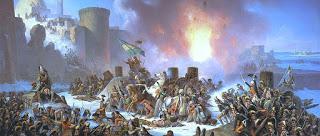 Historians hoping to verify this mad incident run into extreme difficulties. The earliest recorded version comes from an Austrian Military Magazine published fifty years after the event, which gives only a brief account. This appears to be the source for later historians, namely Paul Bernard, whose 1968 biography of Joseph II incorporates the lurid details above and arrives at the 10,000 casualty figure. Bernard's account informs Geoffrey Regan's Great Military Blunders, an entertaining but unsourced collection of military anecdotes, which in turn inspires articles on Cracked and other websites.
Historians hoping to verify this mad incident run into extreme difficulties. The earliest recorded version comes from an Austrian Military Magazine published fifty years after the event, which gives only a brief account. This appears to be the source for later historians, namely Paul Bernard, whose 1968 biography of Joseph II incorporates the lurid details above and arrives at the 10,000 casualty figure. Bernard's account informs Geoffrey Regan's Great Military Blunders, an entertaining but unsourced collection of military anecdotes, which in turn inspires articles on Cracked and other websites.The incident seems to have some historical basis, but the reality appears much more mundane. Joseph described the incident in a letter to his brother Prince Leopold:
Though Joseph's account comports roughly with the legendary "battle," it's telling that he details only material damage, implying that human casualties were either light or nonexistent. Another account from a German periodical suggests that the action was soon followed by a rearguard battle with Turkish cavalry, which left some 150 Austrian soldiers dead and hundreds more wounded or missing. It seems likely that these two incidents, a momentary hysteria and a battle with a real enemy, were somehow conflated over time.
"Everything was preceding in the greatest order and we would have arrived in Caransebeș without the enemy's knowledge for it was night. All of a sudden a group of Wallachians... became alarmed and fired their rifles which threw a unit of hussars and dragoons into confusion... They answered this fire before finally attacking the infantry...The column in which I found myself was completely dispersed. Cannons, wagons and all the tents were turned over; it was horrible; soldiers shooting at each other! Eventually calm was restored, and we were lucky that the Turks were not on our trail otherwise the whole army would have been destroyed. Nevertheless, we lost not only all the pots and tents with considerable damage to other baggage but also three pieces of artillery."
Regardless of what exactly occurred, the setback at Caransebeș was temporary. Joseph reformed his army near Lugoj, standing off the Turks while Austrian forces in Hungary and Galicia counterattacked against the Turks. The war dragged on for several years; Austrian troops under Ernst Freiherr von Loudon finally seized Belgrade in the fall of 1789, while the Russians made gains along the Black Sea. Joseph died from an illness contracted at the front in 1790; his successor, Leopold II, negotiated a peace treaty the following year, giving Austria minor territorial gains along the Danube.
Like many 18th Century conflicts, the Austro-Turkish War was a relatively needless conflict that achieved little beyond the deaths of thousands of soldiers. That it's most famous for a quasi-mythical event says a lot. Sadly, those searching for historical trivia will find that even the Battle of Karansebes doesn't live up to the hype.
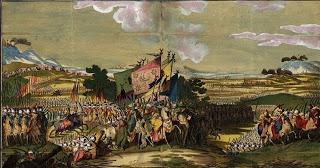 Note: This article draws mainly upon Matthew Z. Myers' doctoral dissertation, "Joseph II and the Campaign of 1778 against the Ottoman Turks," which is available online here.
Note: This article draws mainly upon Matthew Z. Myers' doctoral dissertation, "Joseph II and the Campaign of 1778 against the Ottoman Turks," which is available online here.For another work of historical debunkery, see my article on the sinking of the Raifuku Maru.

